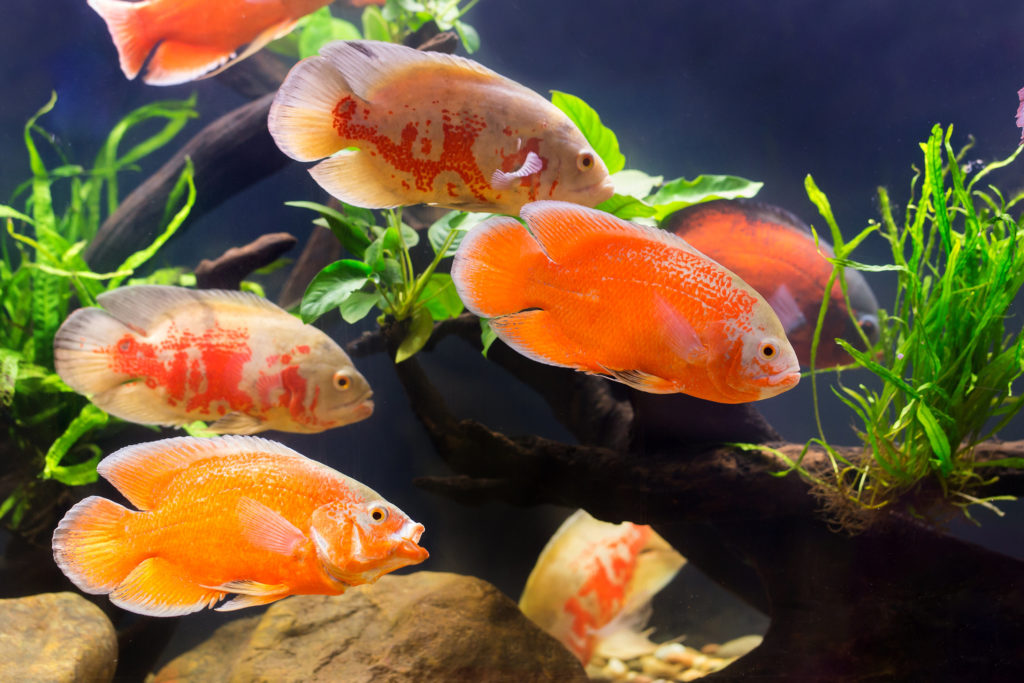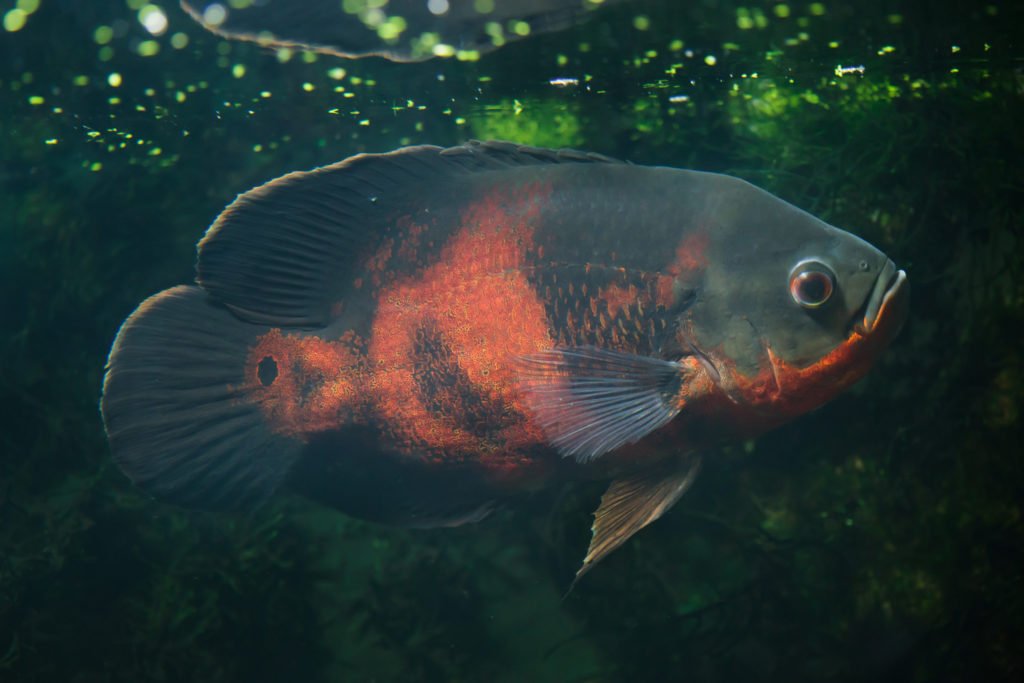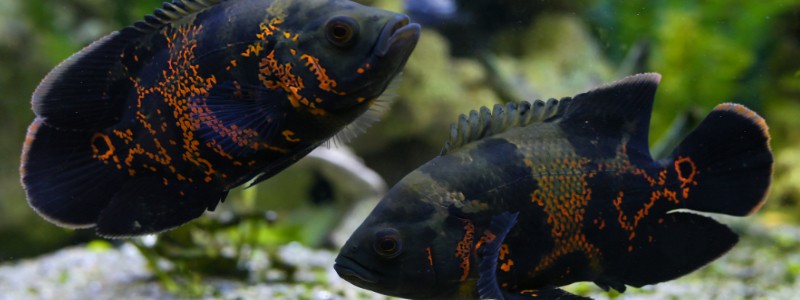Quick Overview
- Family: Cichlid
- Scientific Name: Astronotus ocellatus
- Care level: Fastidious
- Temperament: Aggressive
- Diet: Omnivore/Carnivore
- Water conditions: Freshwater, tropical temperature 75° to 81°F, pH around 7.2
- Max Size: 18 inches in the wild, 12 inches in captivity
- Minimum tank size (as an adult): 50 gallons
Brief Overview: Oscar Fish Care
Keeping an aggressive fish can be very rewarding if you have the capacity for the large tank they require. Oscars are a fascinating candidate as a popular South American member of the cichlid family. They have a dark, brooding appearance but can also be very colorful. An Oscar’s body is most often a mottled combination of black and bright orange or red – and the patterns will change as the fish grows.
The face of an Oscar has a lot of personality. The mature Oscar can have highly developed “lips” and expressive eyes. It is an intelligent animal and you may find it studying your behavior as much as you watch it.
You will most often keep one Oscar in one large tank, so you will get to know the personality of this fish very well. You’ll discover its likes and dislikes and you may have the opportunity for close contact – Oscars are known to let their owners hand-feed or even pet them.
Oscars are among the smartest aquarium fish and will recognize when you are preparing to feed them. They will acknowledge your presence and may seem to try to get your attention. Some people will even float something like a ping pong ball on the water. The curious Oscar will investigate the object – making some claim that they “play.”
No matter how much playtime you get with your Oscar, you will find your relationship to be a developed and caring one, unusual among the cold-blooded housemates we keep in aquariums.

Oscar Fish Appearance
What size are Oscars when they’re small?
When Oscars are purchased in a typical American pet store, they are usually 1 to 2in long. Most often, they are black with orange or red-orange markings. You may also find light-colored/albino Oscars which can be almost white with orange spots. Variations have them mostly black and mostly red or orange.
How fast/slow should you expect Oscar fish to grow?
Oscars will grow very quickly, especially if you give them a live feed. They can gain more than an inch per month, reaching full size after a year or so.
What’s their max size?
Oscars usually grow to about twelve inches in captivity, but there are always exceptions. In the wild, eighteen inches is more typical, so depending on the size of your tank and conditions you may find your pet growing bigger. An Oscar will grow more than in length – they also get wider with age. So even if yours tops out at twelve inches, you may find it maturing and getting larger.
Different Types of Oscar Fish
All South American Oscars are the same species, Astronotus ocellatus, but you’ll find them sold as different types based on the markings, such as Velvet Oscar, Walnut Oscar, or Peacock Oscar, although this name is usually reserved for African Cichlids. Popular variations include:
Red Oscar: A typical Oscar is a dark black or grey with a mottled pattern of bright orange or bright red. When the colored markings are larger than the black markings, they will often be sold as Red Oscars.
Tiger Oscar: As you may expect, the orange patterns on the black body tend to conform to stripes
White Oscar: An albino Oscar, typically white with fewer orange spots
Oscar Fish Diet & Feeding
What do Oscar fish eat in the wild?
Oscars live in South American river basins, where they survive on insects and other available foods. They actually eat a great deal of fruit that falls naturally into their habitat.
Oscar Fish Feeding Habits
As your Oscar matures, you will likely feed it once or twice a day. You can feed it more often when it’s young if you want to see it grow quickly.
Cichlid food comes in various sizes to match the maturity level of your fish. Obviously, start with the smallest size and move up as your fish grows. The more live food you add to their diet, the faster they will grow.
You must take caution with feeding, however, because Oscars will overeat given the opportunity. They are aggressive, competitive fish and are naturally drawn to eating everything available. Give them as much as they can eat in about three minutes at each feeding.
What foods are recommended for Oscar fish?
The best source of food for your Oscar is pellets. This should be the main source of sustenance because they have been well formulated by many manufacturers to provide all the vitamins and nutrients your fish needs on a daily basis. You can supplement with a live feed. You can buy frozen shrimp, worms, and other favorites to serve your Oscar. They eat many insects in the wild, so crickets and grasshoppers are good ways to add to their diet. Even chopped seafood is a good source of natural protein.
It’s generally suggested to avoid feeding your Oscars chunks of animal meat. While this practice was more common in the past, it has been found that the fish’s liver has difficulty processing the saturated fat found in beef or chicken, and that can be bad for its health. Similarly, feeder fish are not recommended for your Oscar because those may introduce diseases into your fish. True, an Oscar is likely to eat much fish in the wild, but unless you can guarantee healthy feeder fish, commercially available food sources are preferred. We recommend you use this type of food to feed your Oscar fish!
Oscar Fish Tank Setup
In its natural habitat, an Oscar lives in the river deltas of South America. So, a tropical freshwater set-up is required. However, it does not like a strong current, so multiple filtration methods are best to keep the tank clean.
Oscars are messy fish with voracious appetites so fastidious cleaning is necessary. Be prepared for regular water changes and be ready to clear any uneaten food out of the tank.
Oscar Fish Tank Size
Each Oscar requires 50 gallons of water to be comfortable. If you’re interested in breeding or keeping other fish, you’ll need at least 100 gallons. Oscars are territorial and predatory, so they need space to swim freely. They like to “patrol,” so they are more comfortable in larger profile tanks compared with taller or hexagonal tanks.
Whatever size tank you choose, be certain it has a firmly fitting lid. Oscars like to jump and may jump straight out of the tank. In the wild, they jump to catch insects and will continue this behavior in captivity. They are strong fish and have been known to push lids out of the way for a chance at imagined prey. To keep your Oscar safe, a lid is required.
Water conditions (Temp., pH, KH)
Tropical freshwater is required to keep Oscars, maintained at 75° to 81°F. Beyond that, cleanliness is most important. Oscars are aggressive and destructive, so in-tank glass heaters are usually broken. Purchase a heater that conditions the water outside the tank or a metal heater that an aggressive fish can’t damage.
Decorations
You’ll find it difficult to keep much decoration in an Oscar tank. They are known to destroy many typical items added to the tank. This is especially true of live plants. Most will be torn apart and uprooted if you try to keep them in your tank. Even artificial plants may be torn out, so artificial plants that are weighted with a large base are best.
You should be able to keep large items in your tank such as rocks or pieces of aquarium wood. Keep in mind that the Oscar will like to patrol the tank, so give them free range in your setup. You may also find any décor items you add have moved. Oscars like to dig in your sand or gravel and may aggressively move the items you put in the tank.
Oscar Fish Tank Mates
General Behavior
Oscars are generally placid, but also aggressive fish. In captivity, they most often live alone. They will attack and devour many potential tank mates but may tolerate bottom feeders that stay out of the way.

Some Oscar owners have luck keeping Plecostomus or catfish in the same tank as an Oscar if they often stay out of the way. That being said, catfish can cause problems if your Oscar decides to try to eat it. Some catfish have naturally occurring spikes that can harm your Oscar if he realizes it is too large to swallow and tries to spit it back out.
Most people decide to keep their Oscar fish alone
With a very large tank, one of the more successful methods of including other fish is with a small school of shoaling fish such as silver dollars that are on the move all of the time. Keep in mind that your Oscar alone needs 50 gallons and most potential tank mates need that much volume themselves. The other possibility is keeping similarly aggressive family members from the same geographic area. Here are some possibilities that hobbyists have had success keeping together with Oscars:
- Silver Dollars in groups of three or more
- Jade Eyed Cichlid, a close relative from Central America
- Black Banded Leporinus, a large tankmate that keeps to itself but also can defend itself
- Chocolate Cichlid, another South American Cichlid that can cohabitate a very large tank
How to Keep Oscar Fish Healthy
Common diseases to look out for
Any common tropical fish diseases can infect your Oscar, such as ick or ulcers. The same over-the-counter treatments are suitable for any tropical fish and are sold at your pet store to take care of these problems.
The one illness that is more common in large cichlids is Hexamita, or Hole-in-the-Head Disease. This is apparent when your Oscar loses its appetite and has small holes or pits appearing in its head. If you catch it early, improving water quality may take care of the problem. It is usually brought on by stress, so water changes may eliminate any toxins present.
If the disease does not improve and the holes get larger and develop into lesions, consult a veterinarian for proper treatment. Your vet can prescribe a treatment that you can feed your Oscar and bring it back to good health.
While the holes that show the signs of Hole-in-the-Head disease can be surprisingly symmetrical, they should not be confused with naturally occurring sensory pits. Oscars have these small holes that allow them to sense their surroundings and sometimes they become more obvious in a mature fish. Sensory pits look like small pinpricks in circles in the areas around an Oscar’s eyes.
Tips on keeping Oscars in good health
With any aquarium fish, the best way to cure and prevent diseases is good water quality. Most illness begins with the stress of ammonia or other chemical build-ups in the water. So frequent testing, water changes, and water treatments are always the best medicine. Because Oscars are messy carnivores, this need is simply more acute.

Breeding Oscar Fish
Oscars will definitely breed in captivity in the right conditions. Again, a single Oscar requires 50 gallons of water, so your breeding pair will need 100 gallons – and their activities can produce 100 more Oscars. If you’re prepared for this, Oscar breeding is exciting behavior to witness.
It is not a simple task to breed Oscars because the females are relatively choosy about their mates. If you have a good relationship with your local pet store, they may allow you to introduce males one at a time until you find a compatible breeding partner.
If you’re lucky enough to find two who take to each other, you can watch the fireworks. Oscars mate by jaw locking, grabbing each other by the mouth, and dragging each other around the tank. If this ritual goes well, they will prepare a place to lay eggs. Most often, they will choose a flat rock and will then take turns scrubbing the rock with their lower lips to make it clean and sticky for eggs.
At some point in the cleaning process, an egg tube will stick out on your female Oscar and maybe, too, the male’s sex organ. When everything is perfect, the female will quickly lay tiny white eggs all over the rock. The male will swim behind her and fertilize the eggs. They will fan the eggs with their fins and they will remove any bad eggs with their mouths.
If everything goes well, the eggs will turn from white to tan within a few hours. And they will hatch in a few days.
If they hatch, you must take them immediately into a pristine tank on their own. They are very vulnerable to water conditions at this time and you must get them into fresh clean water as soon as possible. They will feed on their yolk sacs for a few days, and then you can feed them brine shrimp.
Good luck and make sure you’re ready for this endeavor and have a place for the many space-loving fish that may result.
Interesting facts about Oscars fish
Oscars have teeth, but not where you might expect. An Oscar’s teeth are in the back of its mouth. An Oscar will eat by sucking or slurping food into its mouth and will draw it in and chew it once inside using two sets of teeth deep in its mouth.
Many people ask if they can get a bite from their Oscar. The answer is yes, but not a dangerous one. In the unlikely event that they can take your finger deep enough into their mouth, you are not likely to get more than an annoying abrasion from the small teeth they have there.
Is an Oscar fish right for you?
If you have the space requirements to successfully keep one of these colorful South American cichlids and you don’t mind a solitary aquarium inhabitant, Oscar-keeping can be a rewarding experience. If you have the space for more than 100 gallons, you may be able to keep multiple aggressive species in your home. An Oscar gives you the joy of fish-keeping, plus introduces you to fish with personality. Among the world of freshwater aquarium denizens, they are among the smartest and most colorful housemates you can choose.






